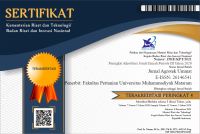The effect of wheat flour and rice flour formulation on organoleptic characteristics of papaya crispy (Carica papaya L.)
Abstract
One of the food processing innovations that can be done from young papaya fruit is made into crispy papaya which is made by adding ingredients such as flour and spices which are intended to improve the texture and taste of crsipy papaya. formula is needed to produce crispy papaya products that are crispy and delicious. The aim of this study to determine the effect of a mixture of wheat flour and rice flour on the organoleptic characteristics of crispy papaya. In this crispy papaya research using the one-factor Completely Randomized Design (CRD) method, namely the mixture of wheat flour and rice flour whose treatment consists of A1 (60% Wheat Flour: 40% Rice Flour), A2 (65% Wheat Flour: 35% Rice Flour), A3 (70% Wheat Flour: 30% Rice Flour), A4 (75% Wheat Flour: Rice Flour 25% and A5 (Wheat Flour 80%: Rice Flour 20%). The data obtained were then analyzed using analysis of variance at the 5% level and if significantly different data were obtained, further tests would be carried out using Honest Real Differences (5%). After conducting the research, it can be seen that the mixture of wheat flour and rice flour in crispy papaya has no significant effect on organoleptic characters in all parameters of the hedonic and scoring test methods. For the organoleptic quality parameters of crispy papaya, the highest treatment was produced in the hedonic test for color parameter A2 treatment (like), texture parameter A3 treatment (like) and taste parameter A1 treatment (like). The scoring test resulted in the highest value of color in treatment A2 (yellow), texture in treatment A3 (crispy) and taste in treatment A4 (no papaya flavor).
Keywords
Full Text:
PDF (Bahasa Indonesia)References
Arif, D. Z., Cahyadi, W., dan Firdhausa, A. S. (2018). Kajian Perbandingan Tepung Terigu (Triticum aestivum) Dengan Tepung Jewawut (Setaria italica) Terhadap Karakteristik Roti Manis. Pasundan Food Technology Journal, 5(3), 180–189.
Cicilia, S., Basuki, E., dan Prarudiyanto, A. (2018). Pengaruh Substitusi Tepung Terigu Dengan Tepung Kentang Hitam (Coleus tuberosus) terhadap Sifat Kimia dan Organoleptik cookies. Jurnal Ilmu dan Teknologi Pangan, 4(1), 304–310.
Istinganah, M., Rauf, R., dan Widyaningsih, E. N. (2017). Tingkat Kekerasan dan Daya Terima Biskuit Dari Campuran Tepung Jagung Dan Tepung Terigu Dengan Volume Air Yang Proporsional. Jurnal Kesehatan, 10(2), 83–93.
Kurniawati, dan Ayustaningwarno, F. (2012). Pengaruh Substitusi Tepung Terigu Dengan Tepung Tempe Dan Tepung Ubi Jalar Kuning Terhadap Kadar Protein, Kadar β-Karoten dan Mutu Organoleptik Roti Manis. Jurnal of Nutrition College, 1(2), 344–351.
Maria, Y. (2018). Pemanfaatan Tepung Ubi Jalar Orange dan Tepung Daun Kelor sebagai Subtitusi Tepung Terigu pada Pembuatan Stik Kue Bawang , Kandungan Gizi, dan Daya Terimanya. Universitas Sumatera Utara.
Pradipta, I., dan Putri, W. (2015). Pengaruh Proporsi Tepung Terigu dan Tepung Kacang Hijau Serta Substitusi Dengan Tepung Bekatul Dalam Biskuit. Jurnal Pangan dan Agroindustri, 3(3), 793–802.
Putri, S. (2014). Pengaruh Substitusi Nangka Muda (Artocarpus heterophyllus Lmk) Terhadap Kualitas Abon Ampas Tahu. Jurnal Kesehatan Holistik, 8(4), 203–208.
Rahayu, W. P. (2001). Penuntun praktikum penilaian organoleptik. Institut Pertanian Bogor.
Rahman, S., dan Dwiani, A. (2021). Pengaruh Substitusi Tepung Tapioka dan Tepung Terigu serta Lama Waktu Pengukusan terhadap Mutu Kerupuk Sape. AGROTEK UMMAT, 12(1), 45–57.
Sabila, M., Suter, I. K., dan Ina, P. T. (2020). Pengaruh Perbandingan Terigu dan Tepung Beras Merah (Oryza nivara) Terhadap Karakteristik Kue Lumpur. Jurnal Ilmu dan Teknologi Pangan, 9(2), 161–169.
Salman, Y., Syainah, E., dan Helmina. (2015). Pengaruh Proporsi Daging Ayam (Gallus gallus) dan Jantung Pisang (Musa paradisiaca) terhadap Kadar Protein, Kadar Serat, Kadar Air dan Daya Terima pada Abon. Jurkessia, 6(1), 1–9.
Setiabudi, R. A., dan Batubara, S. C. (2022). Optimasi dan Formulasi Tepung Beras, Tepung Maizena, dan Tepung Tapioka Dalam Pembuatan Abon Nabati Pepaya dan Wortel Menggunakan D-Optimal Mixture Design. Jurnal Universitas Sahid Jakarta, 4(1), 37–48.
Wanita, Y., dan Wisnu, E. (2013). Pengaruh Cara Pembuatan Mocaf Terhadap Kandungan Amilosa dan Derajat Putih Tepung. Prosiding Seminar Hasil Penelitian Tanaman Aneka Kacang dan Umbi, 22, 588–596.
Winarno, F. . (2004). Kimia Pangan dan Gizi. PT Gramedia Pustaka Utama.
Yuniartini, N. L. P. S., Dwiani, A., Rahman, S., dan Nugrahani, R. (2022). Pelatihan pembuatan abon pepaya muda kepada kelompok wanita tani di Dusun Pidendang Desa Pemepek Kecamatan Pringgarata Kabupaten Lombok Tengah. Rengganis Jurnal Pengabdian Masyarakat, 2(2), 247–252. https://jurnalfkip.unram.ac.id/index.php/JPPM/issue/view/164.
Zainal, Laga, A., dan Rahmatiah. (2018). Studi Pembuatan Brownies Kukus dengan Substitusi Tepung Daun Singkong (Mannihot utilissima). 1(11).
DOI: https://doi.org/10.31764/jau.v10i1.12877
Refbacks
- There are currently no refbacks.
Copyright (c) 2023 Nugrahani & Yuniartini

This work is licensed under a Creative Commons Attribution-ShareAlike 4.0 International License.

 |  |  |  |
| |||
 |  |  |
|
Alamat Kantor












